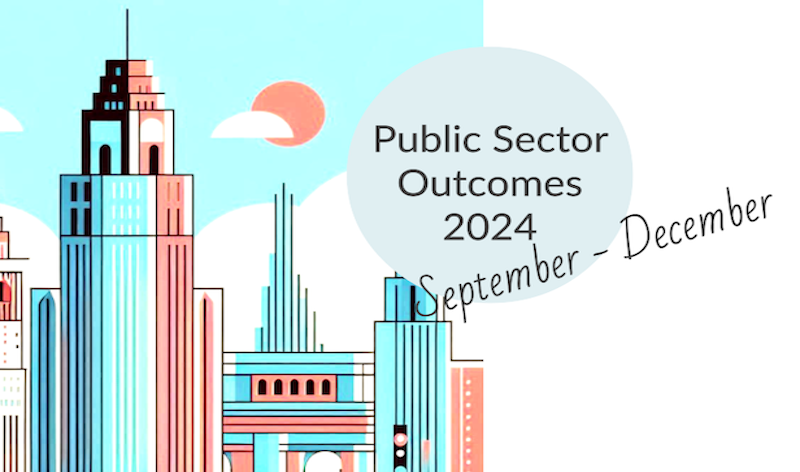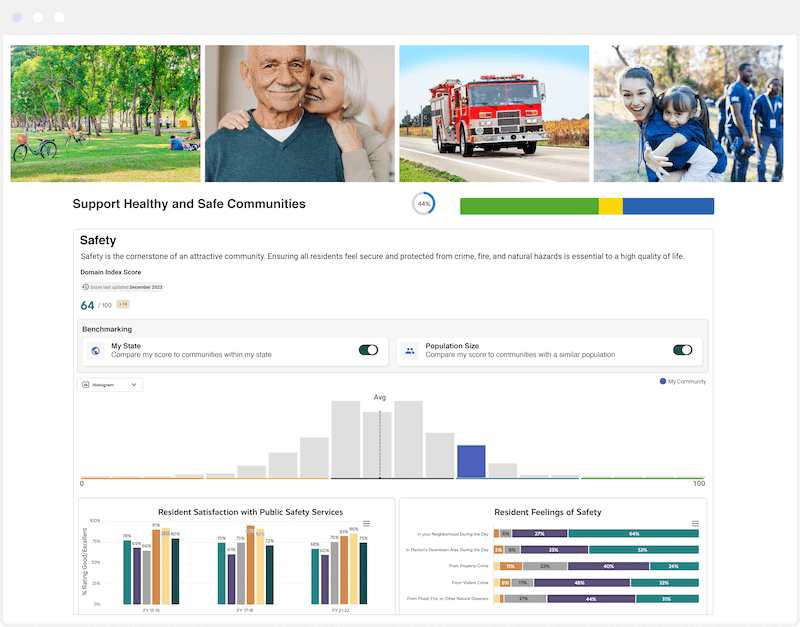Contents
- 1. Get buy-in from employees and elected leaders
- 2. Use visualizations and written context for easy-to-understand updates
- 3. Keep your updates regular and honest (progress and disruptions)
- 4. Keep accessibility front-of-mind
- 5. Make a splash! Promote your public dashboard and provide avenues for feedback
It’s no secret that residents want more transparency from their local governments–however, providing it is not always easy.
Building and sharing a dashboard that communicates organizational performance publicly is one of the best ways that local governments and other public sector organizations can build trust, accountability, and transparency with their external stakeholders. At Envisio, we’ve helped dozens of cities, counties, and other public sector organizations to launch public dashboards and in doing so, improve communication and trust with the communities they serve.
As an organization dedicated to building trusted institutions, our public dashboards provide a customizable, dynamic tool to increase transparency while putting leaders in the driver’s seat of their own organizational performance narrative.
Below, we’ll look at some of our top tips for building an engaging public dashboard. These will help you to onboard internal teams, launch your dashboard externally, and build trust and transparency with your community.
1. Get buy-in from employees and elected leaders
Nobody achieves anything alone, and that is why getting staff buy-in and engaging employees at all levels of your organization is key to creating and maintaining your dashboard. That engagement will then form the basis for timely, relevant updates that let your stakeholders know where you are in relation to your goals.
Before releasing your public dashboard externally, allow time and space for your internal teams to get comfortable with it. Show your teams that your dashboard is going to celebrate the hard work they’re doing and align it with a bigger strategy—and that it will help the public see your progress and monitor any key disruptions.
As well as engaging your staff, it’s important to also foster buy-in from your elected officials (if you have them) as early as possible. Hitting roadblocks with council members is often where we see delays in the process of launching a community dashboard.
While many elected and non-elected local leaders aspire to provide greater transparency to residents, publishing performance results regularly and honestly can feel like a daunting initiative that will open up leaders and staff to unwanted scrutiny. Being able to clearly articulate the benefits of community transparency is the most important piece to fostering buy-in and excitement with your elected officials.
The single biggest reason for greater transparency is to build public trust. Trust is fundamental to a healthy democracy and is an essential part of the fabric that holds our communities together. Research tells us that increased trust improves community relations, bolsters democratic engagement, and increases effective policy making.
Explaining the “why” to both staff and elected officials is critical.
2. Use visualizations and written context for easy-to-understand updates
As a local government or public sector organization, you’ve got data – lots of it. And having data is good, because we want to use it, in part, to tell the story of your results and progress to key stakeholders. However, while data is the best way to tell the story of your organizational performance, doing so in a concise, easy-to-understand manner is just as important as collecting the data in the first place.
That’s where visualizations come in. Your residents or stakeholders are busy people, and it’s important to arrange your data in a way so as to effectively communicate your results while respecting their time. Charts, graphs, and scorecards are effective tools for letting your community know whether you’re on track with your strategic priorities, or whether you need a little more time to achieve your goals.
And while quantitative measures and their corresponding visualizations are going to be a big part of how you tell the story of your organization’s progress, but they can’t be the only part – including qualitative measures and written updates from key staff members can provide valuable context into what you are doing to better the lives of your residents.
3. Keep your updates regular and honest (progress and disruptions)
A big part of building trust with your stakeholders involves communicating clearly what you intend to do, and doing it – and while this may seem self-evident, you’d be surprised at how many organizations fall down at this stage. When it comes to your public dashboard, you need to tell your community or key stakeholders what kind of update schedule they can expect, and then stick to that schedule no matter what. Nothing erodes trust faster than failing to do what you say you are going to do!
As a practical matter, how often you update your dashboard is at your discretion, and will most likely correlate directly to the amount of manpower you have at your disposal. However, it’s important to remember that technology tools (like Envisio!) can go a long way in compensating for something like a lack of team availability. And while there’s no firm rule for how often you need to update your public facing dashboard, you want to keep the information current and relevant to your community.
But updating your dashboard regularly is just the first piece of the puzzle.
At Envisio, we believe that trust and transparency are the foundation on which our institutions are built – and as much as we want to continuously make progress towards our goals, sometimes disruptions happen. Because of this, we believe that providing an honest snapshot of your progress (or sometimes, a lack thereof) is essential when it comes to constructing and updating your public dashboard. And though it might be tempting to communicate only the parts of your plan that are going, well… according to plan…Being open and honest about setbacks helps to build trust with your community and drives greater accountability and focus on solving problems internally.
4. Keep accessibility front-of-mind
As many as one in five American adults identifies as either hearing or vision impaired – that means as much as twenty percent of your audience may need assistance in accessing your web content.
With such a large cross-section of constituents struggling with these issues, making your community dashboard accessible is critical to ensuring that you’re communicating your results in a way that reaches all of your relevant stakeholders.
On an ethical note, this is absolutely the right thing to do, and an important part of ensuring that your organization provides fair, equitable access to information.
On a more practical level, there are legal reasons to ensure that your community dashboard is accessible to anyone who may want to visit it. There are significant legal and financial risks to not complying with current accessibility laws – in the last 10 years, 140+ municipalities have been sued on the basis of website non-compliance under the 1990 Americans with Disabilities Act (ADA).
Being aware of the different challenges your online users may face, and taking action to provide alternatives, is a great way to ensure equity and transparency while reducing any potential risk of litigation. Download our guide on building engaging community dashboards for a more comprehensive accessibility checklist.
5. Make a splash! Promote your public dashboard and provide avenues for feedback
You’ve got leadership and employee buy-in, you’ve built easy-to-understand visualizations that paint an honest picture of your progress, and you’ve made sure that it’s accessible for those who might be vision or hearing impaired.
You might be asking yourself… what’s next?
The end to all your hard work in building your dashboard is really just the beginning. For our final essential tip, we’re going to suggest that you make sure your dashboard is easy to find, and that you work avidly to promote it and provide avenues for feedback from your constituents or key stakeholders. At the end of the day, you are here to serve them – an essential part of doing that is giving them the opportunity to tell you what is working and what isn’t.
Remember, the dashboard is meant to provide valuable insights into how you are working to make their lives better – however, this is only possible if residents are made aware of its existence, and are kept up-to-date on things like fresh updates, new features, or annual reports and summaries. Social media channels, e-newsletters, and email outreach can be effective tools for communicating with your residents, and doubly so if you are using it to promote your engaging new dashboard!
Interested in learning more about building an engaging community dashboard? Check out our guide!





